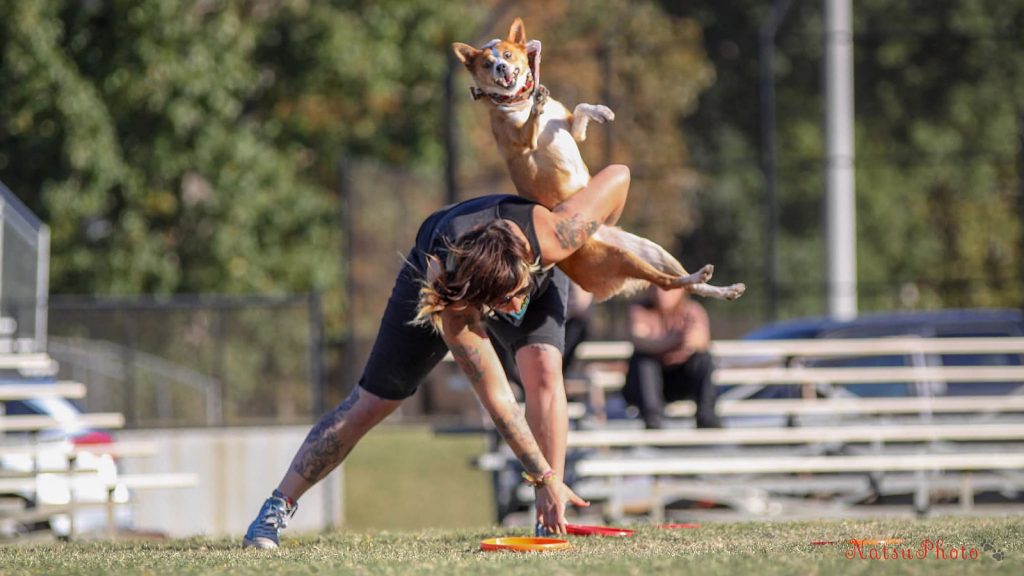
On Disc Management: More Than Picking Up Discs
Abby Cline, of PVybe Fargo and Extreme Stunt Dog Fame demonstrates an amazing multitasking ability. Can you say “Disc Management”?

More Than a Pick Up
While this particular example of Disc ManagementDisc Management is a disc dog term that describes management and organization of discs throughout the routine. Disc Management is a scored category in most disc dog freestyle organizations and has great impact... More is picking up a disc, the pick up is not the amazing part. It is the set up atop of the discs and intent of the handler to do it which is special. Abby set up her Dog Catch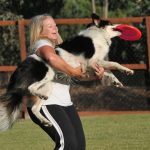 A Dog Catch is a great trick to use for hitting the crowd or for putting a strategic pause in your routine. The dog leaps to catch the disc and then you catch... More and/or the Dish
A Dog Catch is a great trick to use for hitting the crowd or for putting a strategic pause in your routine. The dog leaps to catch the disc and then you catch... More and/or the Dish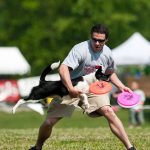 A Dish is a Dog Catch dismount. Cribbed from competitive cheerleading, the Dish is how a dog gets from the handler’s arms to the ground. The very idea of a Dish transforms a... More (dismount) right on top of that disc and leveraged the body position of the trick to create a rather spectacular illustration of Disc Management.
A Dish is a Dog Catch dismount. Cribbed from competitive cheerleading, the Dish is how a dog gets from the handler’s arms to the ground. The very idea of a Dish transforms a... More (dismount) right on top of that disc and leveraged the body position of the trick to create a rather spectacular illustration of Disc Management.
If I had to guess, I’d guess that this move escaped the Player judge’s attention. Things happen fast out there; I watched her round critically and didn’t notice it.
But let’s focus on the set up and intent aspect to this ridiculous piece of disc management and talk a little bit about that.
Purpose Driven Drop
Handling and managing the discs while they are in the dog’s mouth, before they fall out and hit the ground is a key element of Disc Management, and I don’t think it is on many Player Judges’ radar. I don’t think it is in any rulebook (UpDog, maybe, excluded… Go Jack!), but it is a fact of Disc Management, nonetheless.
A cued Drop lets the handler to choose the where the discs rest on the field. A pattern can be created to help execute the plan. A non-cued Drop or drop on opportunity means the handler scrambles from disc to disc. All things equal, which player’s Disc Management is superior?
Leveraging the Cued Drop
The Drop Cue should be obvious to the Player Judge. If it is not it is the job of the Player Judge to look for it and see if it is there. Whether a verbal trigger or a physical one, a clear signal to drop a disc and tactical cued Dropping should be a factor in the disc management score by the player Judge. It is a point of great leverage for the handler. Players that cue Drop to their advantage, whether verbal or physical, are demonstrating enhanced, handler controlled Disc Management while the disc is in the dog’s mouth.
All things equal, the player that calls the tune should be scored better than the player that responds to or keeps up with the rhythm. This is not an argument for organized or structured play over organic or live play, it is about all things being equal except for the intent, teamwork, and structure of a cued Drop.
Setting Up With Purpose
In Abby’s case, the discs were happenstance drops in an interior sequence, but her set up above them; the presence of mind and the plan is where the Disc Management magic happens. Abby displayed intent and structure to pull off this ridiculous skill – a monster turn down dish while picking up her next disc. If I recall correctly, Abby picked this disc up and popped a leaping catch directly at the judges in #attitude style.
It’s not just the pick up that’s impressive. The plan to pick up, the set up in relation to, and the usage of the discs on the ground while doing that trick is impressive and often hidden Disc Management.
More Than Prepared
I think most good judges see this, but most likely undervalue it; suspending judgement until the results of the throw come in. A memorable throw and catch or terrible throw can make this epic disc management a forgotten gem. But the Disc Management was done and done well. Every bit as well as the dog running back from hither and yon to a handler prepared with a handful of discs. It is important to seek, recognize, and remember Disc Management of this nature by the handler as a disc dog enthusiast or judge.
Throwing far, gathering, and being prepared with a stack of discs, only to respond to an approaching dog with a quick stop or flowing Through A Through is a set up move where the dog runs between the handler’s legs. The dog can move from front to back or side to side and can even weave. A Through... More in Front
A Through is a set up move where the dog runs between the handler’s legs. The dog can move from front to back or side to side and can even weave. A Through... More in Front Front is a stable position directly in front of the handler. Front is an traditional obedience skill. Usually your dog sits in this position, but standing is often acceptable as well, especially in... More PositionIn the Play+ philosophy, "Position" is the final stage within the "Next" phase of a Cycle of Play. It acts as a pivotal link between the "Next" phase and a new "Now" phase. More is a good move to gather the team, completely acceptable, but it is not the only move for Disc Management.
Front is a stable position directly in front of the handler. Front is an traditional obedience skill. Usually your dog sits in this position, but standing is often acceptable as well, especially in... More PositionIn the Play+ philosophy, "Position" is the final stage within the "Next" phase of a Cycle of Play. It acts as a pivotal link between the "Next" phase and a new "Now" phase. More is a good move to gather the team, completely acceptable, but it is not the only move for Disc Management.
This kind of Disc Management and the calculated cued drop to set it up is at least equal to a long throw made to hide the picking up of discs and most other Art of the Invisible Pickup moves being used. Ideally the handler employs them all to demonstrate competence in the Disc Management category, some long tosses to get it together, the calling of the Drop at the opportune time, and usage of discs on the field for navigation and set up.
Fast ≠ Frantic
Fast is not frantic and frantic is not at all fast. Sprinting and moving fast is often just fancy cover for poor planning and mechanical problem; usually the lack of a cued Drop. Yet, many judges expect people to move, and move rapidly, for Disc Management purposes. To not do so is to be slow or lazy.
Good Disc Management is not only being prepared to play, but being prepared in style and without effort. Signaling the Drop at the opportune time and leveraging discs on the ground with a planned, perfect set up are aspects of Disc Management that should not escape the judge’s eye. These same aspects of Disc Management should be worked by players and teams as a way to improve and exercise Disc Management.





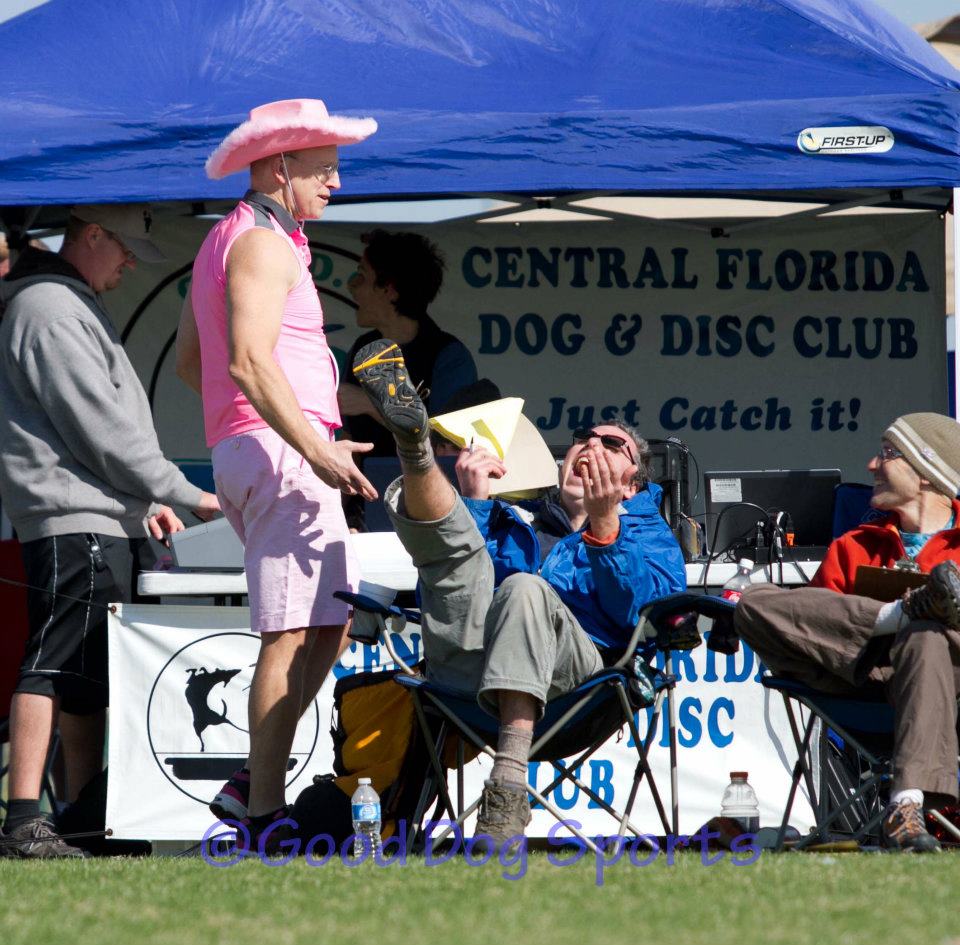
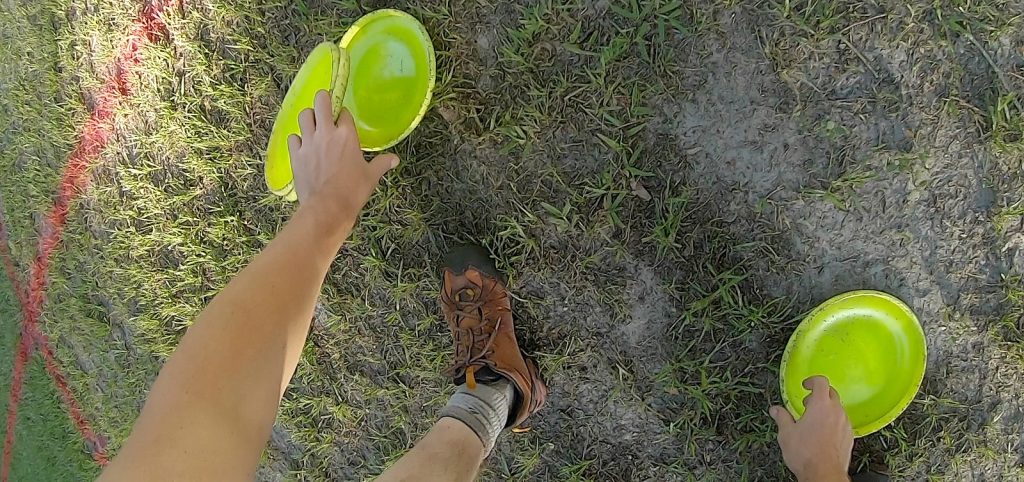


Responses